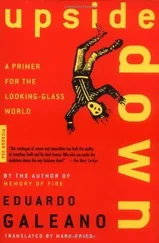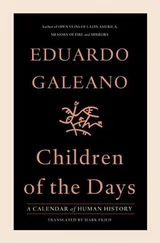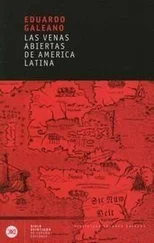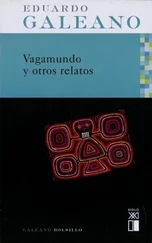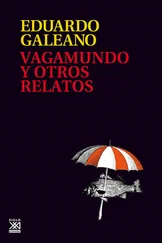
Official history has it that Vasco Núñez de Balboa was the first man to see, from a summit in Panama, two oceans at once. Were the natives blind?
Who first gave names to corn and potatoes and tomatoes and chocolate and the mountains and rivers of America? Hernán Cortés? Francisco Pizarro? Were the natives mute?
The Pilgrims on the Mayflower heard Him: God said America was the promised land. Were the natives deaf?
Later on, the grandchildren of the Pilgrims seized the name and everything else. Now they are the Americans. And those of us who live in the other Americas, who are we?

On the eve of every assault on a village, the Requerimiento of Obedience explained to the Indians that God had come into the world and left Saint Peter in his place and that Saint Peter named the pope as his successor and the pope had bestowed all these lands on the queen of Castile and for that reason they must either leave or pay tribute in gold and in case of refusal or delay they would be attacked and they and their women and their children would be enslaved.
This Requerimiento was read at night in the wild, in the language of Castile without interpretation, in the presence of a notary and not a single Indian.

The great city of Tenochtitlán was of water born and of water built.
Dikes, bridges, sewers, canals: along streets of water two hundred thousand canoes traveled back and forth between houses and squares, temples, palaces, markets, floating gardens, planted fields.
The conquest of Mexico began as a water war, and the defeat of water decreed the defeat of everything else.
In 1521, Hernán Cortés laid siege to Tenochtitlán, and the first thing he did was take an ax to the wooden aqueduct that carried drinking water from the Forest of Chapultepec. Following many massacres, when the city fell, Cortés ordered the temples and palaces demolished and the rubble thrown into the liquid streets.
Spain did not like water, the devil’s toy, a Muslim heresy.
Vanquished water gave birth to Mexico City, raised on the ruins of Tenochtitlán. Engineers picked up where the warriors left off and, over many years, they blocked up with stone and earth the entire circulatory system of the region’s lakes and rivers.
Then water took revenge, flooding the colonial city repeatedly, which only confirmed that it was an ally of the pagan Indians and the enemy of all good Christians.
Century after century, the dry world waged war on the wet world.
Now Mexico City is dying of thirst. In search of water, it digs. The deeper it digs, the further it sinks. Where once there was air, now there is dust. Where once there were rivers, now there are avenues. Where once water flowed, now traffic streams by.

Hernán Cortés conquered Tenochtitlán with a force of six hundred Spaniards and innumerable Indians from Tlaxcala, Chalco, Mixquic, Chimalhuacan, Amecameca, Tlalmanalco, and other peoples humiliated by the Aztec Empire and tired of bathing the steps of the Templo Mayor in their blood.
They thought the bearded warriors had come to liberate them.

Hernán Cortés threw the ball to the ground. And Emperor Charles and his numerous courtiers witnessed an unprecedented marvel: the ball bounced and flew skyward.
Europe knew nothing of that magic ball, but in Mexico and Central America rubber had been in use forever and the ball game had been around for three thousand years.
In the game, a sacred ceremony, the thirteen heavens above battled the nine underworlds below, and the bouncing ball flew back and forth between darkness and light.
Death was the prize. He who triumphed offered himself to the gods so that the sun in the sky would not go out, and rain would continue to water the earth.

How did Francisco Pizarro, with sixty-eight soldiers, manage to defeat the eighty thousand men of Atahualpa’s army in Peru without a single casualty?
The invaders, Cortés, Pizarro, astutely exploited divisions among the invaded, torn by hatred and war, and with empty promises they managed to multiply their forces against the centers of Aztec and Incan power.
Besides, the conquistadors used weapons unknown in America.
Gunpowder, steel, and horses were incomprehensible novelties. Clubs were useless against cannon and harquebuses, lances and swords, as was cloth armor against steel, or fighters on foot against those six-legged warriors of horseman and horse. No less unknown were smallpox, measles, influenza, typhus, bubonic plague, and other involuntary allies of the invading troops.
And as if all that weren’t enough, the Indians knew nothing of the customs of civilized life.
When Atahualpa, king of the Incas, approached to welcome his strange visitors, Pizarro took him prisoner and promised to free him in exchange for the largest ransom ever demanded. Pizarro got his ransom and chopped off his hostage’s head.
ORIGIN OF BACTERIOLOGICAL WARFARE

For America, Europe’s embrace was deadly. Nine out of every ten natives died.
The smallest warriors were the most ferocious. Viruses and bacteria, like the conquistadors, came from other lands, other waters, other air. And the Indians had no defenses against that invisible army advancing with the troops.
The numerous inhabitants of the Caribbean islands disappeared from this world, leaving not even the memory of their names. Plagues killed many more than the many killed by slavery and suicide.
Smallpox killed the Aztec king Cuitláhuac and the Incan king Huayna Cápac, and in Mexico City its victims were so numerous that entire families were buried by bringing their homes down on top of them.
The first governor of Massachusetts, John Winthrop, said smallpox had been sent by God to clear the way for His chosen people. Clearly, the Indians had settled at the wrong address. The colonists of North America lent a hand to His Holiest on more than one occasion by giving the Indians blankets infected with smallpox.
“To extirpate this execrable race,” explained the commander, Lord Jeffrey Amherst, in 1763.

Nearly three centuries after Columbus disembarked in America, Captain James Cook navigated the mysterious seas of the southeast, planted the British flag in Australia and New Zealand, and opened the way for the conquest of the infinite islands of Oceania.
Due to their white skin, the natives believed those seamen were the dead returned to the world of the living. And due to their acts, the natives learned that they had come to take revenge.
And history repeated itself.
As in America, the recent arrivals took over the fertile fields and the sources of water and pushed those who lived there into the desert.
As in America, they subjected the natives to forced labor and outlawed their memory and their customs.
Читать дальше









